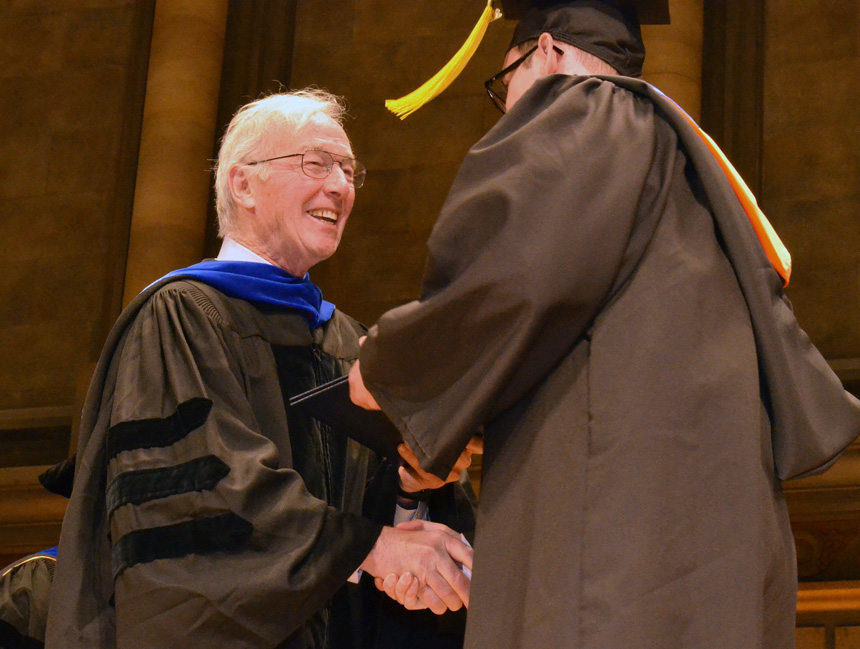Emeritus Prof. Burns looks forward to pursuing research, working with students

Prof. Stephen Burns, who becomes an emeritus professor on July 1, was given the honor of handing out diplomas to Department of Mechanical Engineering graduating seniors at the Hajim School commencement exercise this spring.
For Stephen Burns, professor of mechanical engineering and of materials science, the transition to emeritus professor on July 1 will mean giving up some of his academic perks and duties – but not his passions.
“In a sense you could say I’ve retired my salary – and the ability of the department chair and dean to tell me what to do,” he joked.
However, Burns says he plans to remain a familiar sight in Hopeman Hall, continuing his research and interacting with faculty and students.
Teaching students – and getting to know them – has been the most enjoyable part of his career, Burns said.
“If I had wanted to pursue research alone, I would have been much better off going to a national lab. But I wouldn’t have had the interaction with students,” Burns said. “They keep you going,”
Burns, who received his Ph.D. from Cornell in 1967, taught at Brown University before joining the newly established Materials Science Program at Rochester in 1972 as an associate professor. He served as Chair of the Department of Mechanical Engineering from 2001 to 2007.
An expert in fracture mechanics, Burns has published more than 150 papers. As a graduate student he used a camera capable of taking 2 million frames a second to “watch cracks propagate in single crystals of material,” Burns said. From that, he was able to determine the dynamics of crack propagation, especially the plasticity that occurs at the tips of cracks. He applied this to help design ways to prevent cracking that could split a nuclear power plant pressure vessel in half during a loss of coolant accident (LOCA).
More recently, he has worked on the thermodynamics of superconducting materials and on thermodynamics as applied to high pressure, high temperature solid materials – an area he will continue to explore.
At Rochester, Burns has taught courses in Materials Science, Thermodynamics of Solids, Crystallography and Diffraction with X-rays and Electrons, Fracture and Adhesion, Statics, Strength of Materials, but especially Laboratories in Solids and Materials, plus Basic and Advanced Engineering Thermodynamics.
“His strong commitment to laboratory work and materials characterization has been an important part of both our undergraduate and graduate curriculum,” Department Chair John Lambropoulos said. “His strong commitment to student mentoring and support can be glimpsed from the fact that he has published a paper, on the Grüneisen constant of solids, with all the students in his graduate course on Thermodynamics of Solids.”
Burns said he made a point of not only giving lectures, but attending the recitations as well. “When you’re giving a lecture, it’s difficult to get to know the students,” he explained. “But when you go to recitation and work one on one with them, you find out about their families, about their dreams and aspirations.”
Less visible, but just as important, was the effort he put into the very large number of letters of recommendation he wrote each year, for students applying to graduate schools, for example, or for jobs in industry. “To write a good letter you have to write it so that when people read it, they know that you know the student well. And that’s not easy to do.” In addition, if he was writing on behalf of a student applying to Stanford, for example, “I want to know who is on the faculty in that department, and if I know someone who is there or used to be there, you can compare the student to that person, or when that person was young. I makes the letter much more meaningful.”
Burns has served as a mentor to several junior faculty members in Mechanical Engineering and in Materials Science. Lambropoulos was one of them. ”Professor Burns recruited me to Rochester straight out of graduate school after we had met earlier at an international conference at the National Institutes of Standards and Technology in Gaithersburg, MD and then later at a conference at Cornell University,” Lambropoulos recalled. “He helped me in the writing of some of my early papers and proposals when I was a brand new Assistant Professor, guiding me through the technical processes needed in paper revisions, proposal modifications and generally welcoming me to Rochester.”
Two factors convinced Burns it was time to retire: increasing needs of the undergraduate program and a desire to be more available to provide care, when needed, for his and his wife’s many siblings.
“The University of Rochester has been a wonderful place to work,” he said. “I have been able to set my own pace. I still get excited about research. The area I chose early on is in mechanics and materials; it has suited me well for 50-plus years.”
